Monaco is drenched
Panis was fastest in the dry warm-up, his Ligier fully realising the potential of its speed. But that’s when the rain came pouring down. It was furious, relentless and Monaco was soaked. As per F1 regulations, an extra 15-minute session was held in the wet so that drivers could get used to conditions.
Andrea Montermini’s crashing of his Forti outside the tunnel and his team’s lack of a spare car meant that only 21 cars actually started the race.
As the rain stopped and the track began to dry, everybody took to the starting grid with wet tires, apart from Jos Verstappen of Arrows, who reckoned he had nothing to lose from his 12th-place on the grid anyway.
The race
Monaco 1996 was chaos right from the off. Verstappen’s gamble looked to be working, until he clipped Hakkinen while unwisely trying to overtake the Finn and slammed into the wall. Elsewhere, the two Minardis farcically collided into each other. All three were out of the race.
But the most significant elimination was yet to happen. Going past Loews Hairpin, Hill had got away from Schumacher. Then, at the eerily unnamed turn after Loews, the German clipped the inside kerb, hit a wall and came to a stop just before Portier. Pole position was out of the race.
Elsewhere, Rubens Barrichello had slammed his Jordan backwards into the wall at Rascasse. It was unbelievable stuff, watching the cars drop like flies. There were only 16 cars left in the race after the first lap. Then 13 after 5 laps. Then 12 after 10. It was thrills-and-spills like motor racing hadn’t seen for a long time.
It was wonderful symmetry. As the number of retirees kept increasing, Hill’s also kept increasing. It was 4.3 seconds after the first lap, nine-plus after the third and almost 25 after the twentieth. Alesi had no chance of catching him.
But then, disaster struck on lap 40, when Hill’s engine blew up and he had to retire from a race he was dominating. Alesi himself lasted a further 20 laps before being sidelined by a broken rear suspension.
Irvine locks it down
Eddie Irvine had risen to fourth from his starting position of seventh after Schumacher and Barrichello had exited stage left. From then on, for the largest chunk of the race, Irvine drove his Ferrari at plodding pace in the middle of the road, blocking the passage of the cars behind him.
Behind Irvine were Heinz-Harald Frentzen in the Sauber and David Coulthard, wearing a helmet borrowed from Schumacher, in the McLaren. Frentzen tried to overtake Irvine but damaged his front wing doing so. Frentzen might have actually won the race had he been a bit more patient, for after stopping in the pits to replace the car’s nose, he was stuck behind other cars again.
Frentzen actually finished the race, one of the few to do so, but was in the pits during the chequered flag. Coulthard, on the other hand, was undone by his own management. The McLaren team had mystifyingly chosen to give pitting preference to Hakkinen, who was way behind.
The final few laps had only four cars running as Coulthard attempted to chase down Panis amidst tempestuous weather and much thrill. But he just knew the Frenchman was too far out of reach and merely settled for finishing the race.
Olivier the hero
Where, in the midst of this destruction derby, was the actual race winner? Panis had been driving wonderfully. He rose to 12th in the early laps, before going past Martin Brundle, Hakkinen and Johnny Herbert at the Loews Hairpin.
His pit-stop was perfectly timed – he went from seventh to fourth. Faced with Irvine and his attritional driving next, Panis checked inside the Ferrari at the Loews, knocking it into a standstill as he went past. Bit by bit, Panis was clawing back ground as he waged a war for first place with compatriot Alesi.
Finally, as Alesi made for the pits, the moment had arrived. Panis stormed into the gap at the head of the queue left by the Benetton. It was a moment to be cherished as Panis became the first French driver in a French car to win at Monaco – the first since Rene Dreyfus in 1930.
Epilogue
Herbert was the third driver of three to cross the finish line in his Sauber. He hadn’t driven a particularly spectacular race, but in a contest which had lost 18 of its 21 participants along the way, he should be praised for making it over the line in one piece.
But this was Panis’ moment. As he knifed through a maze of cars and turns on his way to victory, Panis had driven with commendable style and steel. In this collector’s item of a race, it was a splendid combination of strategy, finesse and concentration that decided the winner.
Olivier Panis never won another race in F1. But when you win one of the most surreal races in the history of the sport, you get the right to brag a little.

